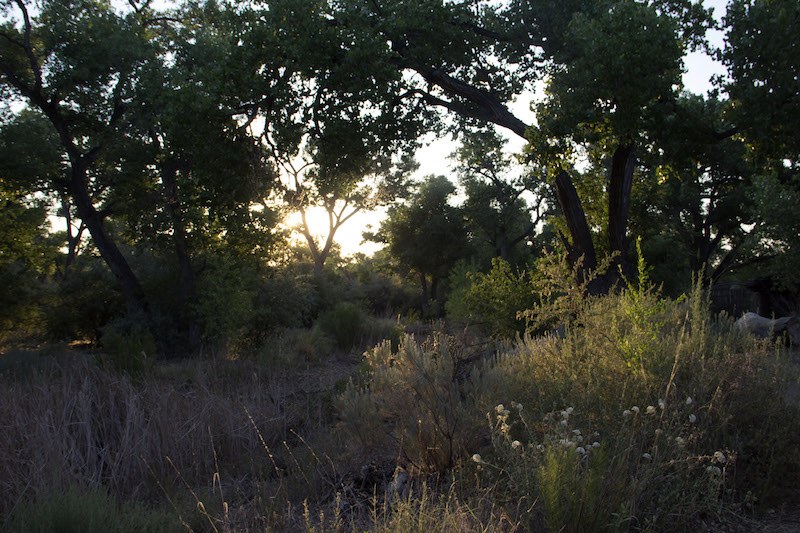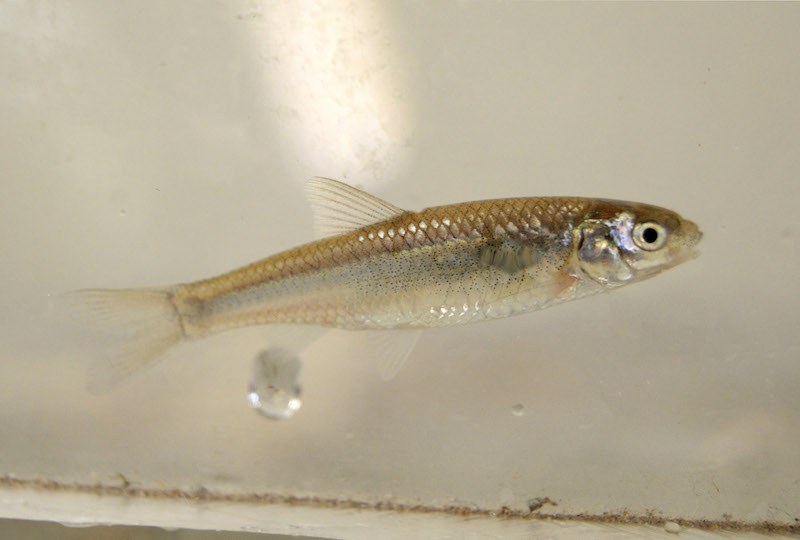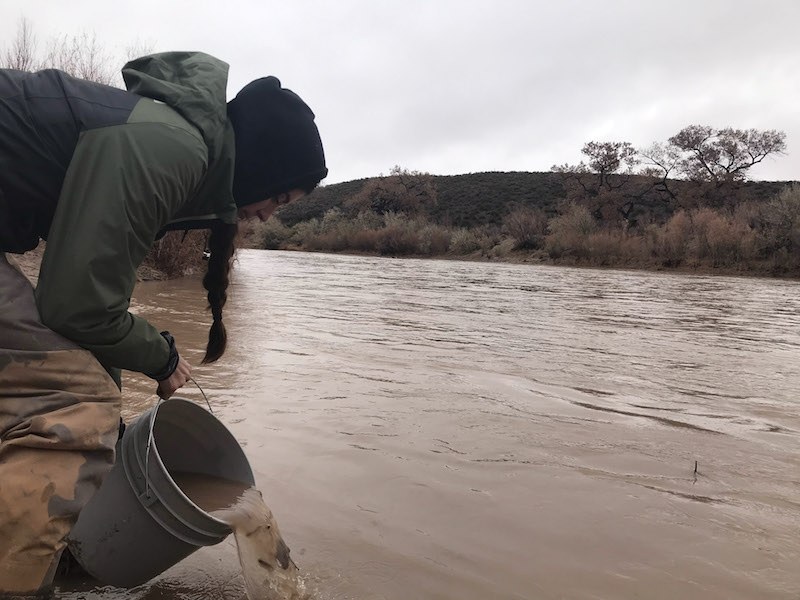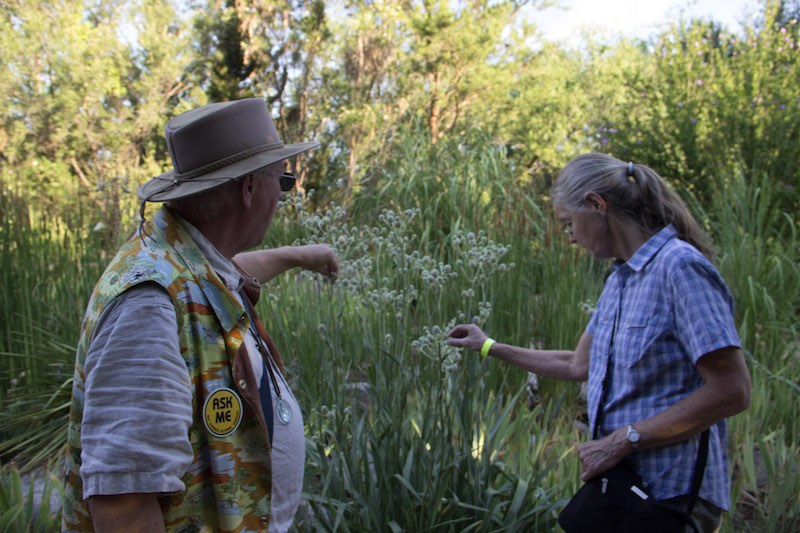The Bosque
Learn about the heart of the forest, the animals that inhabit New Mexico’s cottonwood forest, and the efforts the BioPark is making to restore a native freshwater species.
Learning Goal
Curious about the scaly, feathered and furry animals in the natural world? Explore today’s lesson plan and discover the heart of the Bosque, conservation efforts at the ABQ BioPark Aquatic Conservation Facility (ACF) and how your actions matter.
Introduction to the Bosque

The cottonwood forest that borders the Rio Grande runs through New Mexico; its habitat is both unique and diminishing. It’s known as “the Bosque,” which means “woods” or “forest” in Spanish. Its riparian forests provide an oasis of valuable resources for animals and plants living in an otherwise arid Southwest habitat.
Rio Grande cottonwoods have been growing in the Bosque for more than a million years and are heavily dependent on a reliable water supply for germination and survival. Cottonwoods grow well only where their roots can reach moisture provided by an underground water supply and where their seeds can germinate on bare, moist soil. Cottonwoods are particularly hardy and well suited for the inconstant life of a changing river.
Cottonwood seeds, carried by downy white tufts, are easily dispersed over long distances by wind or water. For germination (when seeds begin to sprout), they need bare soil, moisture and plenty of sunshine. Cottonwoods flower in the spring before their leaves come out. This happens around the same time that spring rains cause the river to flood over its banks, which creates open, muddy flats where seeds can germinate and establish seedings. Cottonwood trees are the heart of the Bosque. They provide critical habitat for many birds, mammals, insects, spiders and crustaceans in this riparian ecosystem.
More than 500 different species of animals claim New Mexico’s Bosque as their home including New Mexico whiptail, gopher snakes, great horned owl, Cooper’s hawk, porcupines and much more.
The BioPark's work to safeguard the Bosque

New Mexico, as a natural landscape, supports one of North America’s most diversified faunas resulting from its diversity of landforms, elevation, vegetation and climatic history. The Rio Grande and its floodplain support a variety of plants and animals.
At the BioPark’s Aquatic Conservation Facility (ACF), scientists work behind the scenes to save New Mexico-native fish species. The ACF holds refuge populations of several fishes and invertebrates native to New Mexico streams and rivers. The ACF has participated in a partnership to help conserve the Rio Grande silvery minnow, Hybognathus amerus, since 2000. This small, chubby fish was once one of the most common species in the Rio Grande. Historically, it was abundant throughout the Rio Grande and Pecos basins, but is now found in only 5 percent of its former habitat. Its current range is limited to a few locations between the Cochiti Dam and Elephant Butte Reservoir. Its population has sharply declined due to dams constructed on the Rio Grande, which have altered the river’s historic flow patterns and changed the water temperature. These factors have prevented minnows from migrating upstream and have made wild breeding and survival difficult. In addition, the introduction of non-native fishes such as the plains minnow have contributed to the silvery minnow’s decline.
In 1994, the Rio Grande silvery minnow was listed as a federally endangered species. Small but mighty, this incredibly small fish has an impressive role to play in the health of the Rio Grande’s food web: it tends to skim the bottom of the river looking for algae to eat and ends up getting eaten as dinner itself by several other animals.

The BioPark started its Rio Grande silvery minnow programs in 1999. ACF staff collects eggs from the Rio Grande in the spring, spawns Rio Grande silvery minnow in captivity, then releases minnows back into the river in the fall. To date, in cooperation with the Middle Rio Grande Endangered Species Collaborative Programs, the BioPark has released more than 800,000 Rio Grande silvery minnows back into the river. With successful repatriation scientists have discovered that the Rio Grande silvery minnow is an indicator of the health conditions of the Rio Grande river system.
Although various conservation efforts are currently in place, the threat of extinction continues for this tiny fish. Additional measures such as water management, better urban and agricultural water conservation practices, and securing pollutants from runoff entering the river need to be established to preserve the river and save this species.
Our Actions Matter

The river and its floodplain support a variety of plants and animals. The Bosque of the Rio Grande is a gem worth protecting. Cottonwoods are refuges for all kinds of creatures, providing nutrient cycling, erosion control and wildlife habitat. Today, the cottonwood trees and the Bosque ecosystem that depends on them face serious threats to their survival. Farming, river-control projects and urban development have dramatically decreased the water supplies, seriously compromising the health of the Bosque. Unfortunately, the Rio Grande and its Bosque have been heavily altered by human activities, especially during the last century. The introduction of non-native plants and animals has also significantly impacted native plants and animals. Two species of introduced invasive plants, tamarisk and Russian olive (Elaeagnus angustifolia), have spread throughout the valley. Russian olives thrive in poor soil, have low seedling mortality rates, mature in only a few years, and soak up water at a much higher rate than native species. They form a dense thick canopy, which outcompetes native cottonwoods.
Today, concerned people and organizations like the ABQ BioPark have initiated a number of programs to monitor and protect the beauty and integrity of the Bosque. Albuquerque’s Open Space Division plants thousands of cottonwoods and other native trees and shrubs each year in an effort to replace the aging forest and reclaim burned areas. The Bosque Ecosystem Monitoring Program, organized by the Bosque School and University of New Mexico, promotes community science, education and stewardship of the Rio Grande ecosystem.
Activity: Hitch a Ride
Plants can’t move on their own, so how are they so widely spread? They depend on wind, water, and even animals to assist in seed dispersal. Some seeds have hooks or barbs that get tangled into an animal’s fur, feathers or skin and hitch a ride to a new site.
Materials
- Fuzzy socks
- Shoes - one pair of sneakers
- Hand lenses (optional)
Directions
- Give each child a fuzzy sock to put over one shoe, fuzzy side out.
- Explain that fuzzy socks are like animal fur; seeds cling to them.
- What is the purpose?
- What role do you have?
- Have kids run, hop, and skip around outside for four to five minutes.
- Ask them to carefully remove the socks.
(Optional) Using a hand lenses:
- What did your socks collect?
- What did they collect the most of?
- Do you see any plants that you did/did not collect anything from? Why?
- Do humans disperse seeds? How?
- Ask them to compare/contrast their findings with a classmate.
Additional Resources
- Albuquerque Open Space works to acquire and protect land designated as public open space.
- With an Albuquerque Public Library card New Mexicans can explore thousands of eBooks, audiobooks and digital downloads from home.
